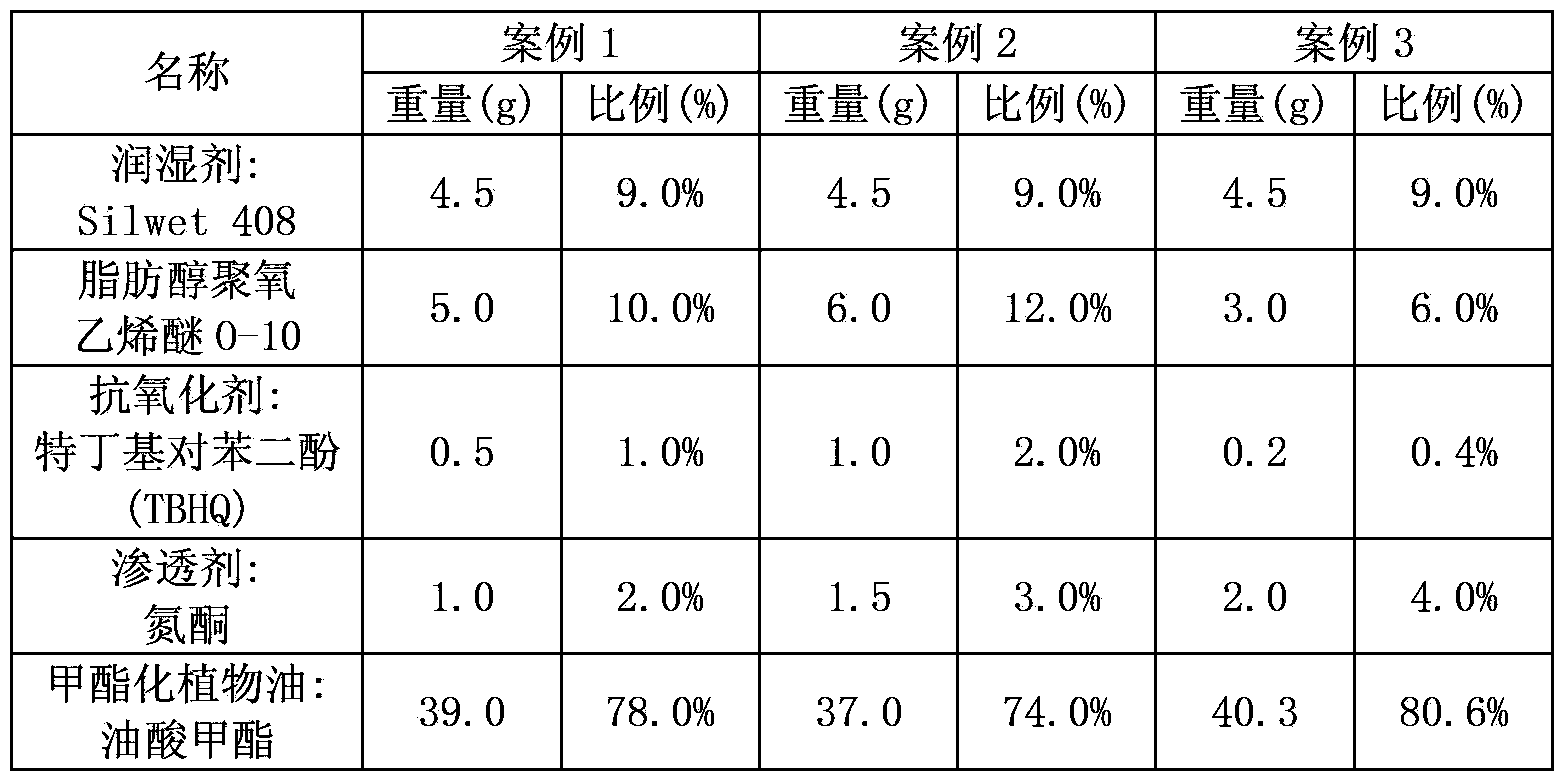Anti-photooxidation plant oil spray adjuvant used for insecticidal pesticide preparation and its use method
An insecticidal pesticide preparation and anti-photooxidation technology, applied in botany equipment and methods, insecticides, plant growth regulators, etc., can solve problems such as endocrine hormone disorders, product color darkening, and product instability, and achieve Delay decomposition, improve wettability, increase the effect of stable retention
- Summary
- Abstract
- Description
- Claims
- Application Information
AI Technical Summary
Problems solved by technology
Method used
Image
Examples
Embodiment 1
[0031] Example 1 Detection of wettability improvement
[0032] Wetting properties of water and common pesticide preparations (36% monosultap SP, 2% abamectin EC, 70% imidacloprid WDG) on rice and wheat leaves before and after adding the adjuvants of the present invention were tested. Note: SP is soluble powder, EC is emulsifiable concentrate, WDG is water dispersible granule, the same below.
[0033] When testing, firstly dilute the pesticide preparation with water, then add the spray auxiliaries of cases 1, 2, and 3 respectively, stir well and then test. The mass ratio of the adjuvant to the diluted pesticide solution is 15%.
[0034]The results are shown in Table 4, showing that the adjuvant of the present invention can significantly improve the wetting performance of water and common pesticide preparations (36% monosultap SP, 2% abamectin EC, 70% imidacloprid WDG) on rice and wheat leaves .
[0035] Table 4 Wetting performance test results
[0036]
Embodiment 2
[0037] Example 2 Maximum Stable Retention Improvement Detection
[0038] Using the dipping method, the commonly used pesticide preparations (36% monosultap SP, 2% avermectin EC, 70% imidacloprid WDG) were detected on the leaves of target plants (rice, wheat and cabbage) before and after adding the adjuvant of the present invention. Maximum stable retention (three parallel experiments).
[0039] When testing, firstly dilute the pesticide preparation with water, then add the spray auxiliaries of cases 1, 2, and 3 respectively, stir well and then test. The mass ratio of the adjuvant to the diluted pesticide solution is 15%.
[0040] The results are shown in Table 5 to Table 7, showing that the adjuvant of the present invention can significantly increase the effect of commonly used pesticide preparations (36% monosultap SP, 2% abamectin EC, 70% imidacloprid WDG) on target plants (rice, wheat and Cabbage) maximum stable retention on leaves.
[0041] Table 5 Test results of maxim...
Embodiment 3
[0048] Example 3 Detection of 2% Abamectin EC efficacy improvement
[0049] Detect the drug effect of 2% avermectin EC on rice leaf roller before and after adding the auxiliary agent of the present invention.
[0050] When testing, firstly dilute the pesticide preparation with water, then add the spray auxiliaries of cases 1 and 4 respectively, stir well and then test. The mass ratio of the adjuvant to the diluted pesticide solution is 15%.
[0051] The results are shown in Table 8, indicating that the adjuvant of the present invention can significantly improve the control effect of 2% abamectin EC on rice leaf rollers under the premise of appropriately reducing the use of pesticide preparations.
[0052] Table 8 Control effect on rice leaf roller
[0053]
PUM
 Login to View More
Login to View More Abstract
Description
Claims
Application Information
 Login to View More
Login to View More - Generate Ideas
- Intellectual Property
- Life Sciences
- Materials
- Tech Scout
- Unparalleled Data Quality
- Higher Quality Content
- 60% Fewer Hallucinations
Browse by: Latest US Patents, China's latest patents, Technical Efficacy Thesaurus, Application Domain, Technology Topic, Popular Technical Reports.
© 2025 PatSnap. All rights reserved.Legal|Privacy policy|Modern Slavery Act Transparency Statement|Sitemap|About US| Contact US: help@patsnap.com



